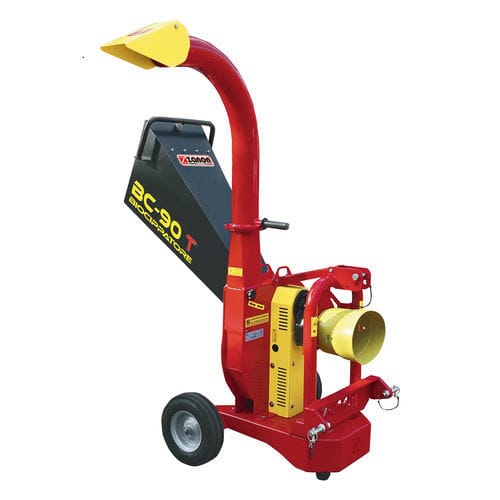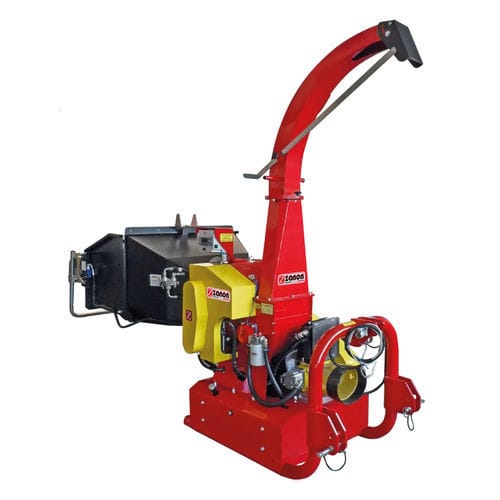
#Farm Machinery & Equipment
Bioshredders and Biochippers: composting solutions
At a time when environmental sustainability is in the spotlight, composting is an important practice to reduce waste and promote the health of our planet. Bioshredders and biochippers are key tools for optimising the composting process.
Agriculture has been a key sector for mankind since the dawn of civilization. Over time, the introduction of agricultural machinery has radically revolutionised the way soils are cultivated and food produced. These technological tools have become essential pillars for increasing efficiency and productivity in agricultural activities.
In this article, we will explore a variety of agricultural machinery and their uses, providing a comprehensive overview of the innovations that have transformed the industry.
Soil tillage machines
Tilling machines are designed to prepare the soil before sowing or planting. These machines can include ploughs, harrows, tillers and hoes. Each machine has its own specific role and distinctive advantages, helping to ensure optimal soil preparation for cultivation. The choice of machine depends on the type of soil, the type of crop and local agricultural practices.
1. Harrows
Harrows are agricultural machines used primarily for surface tillage of the soil prior to sowing. These tools consist of a series of tines or discs mounted on a frame, which are pulled by a tractor. The action of harrows is to break up mounds of soil and level the soil surface, allowing for an even distribution of seeds and better soil aeration.
Advantages of harrows
- Soil preparation: harrows allow soil to be prepared quickly and efficiently, minimising the time needed for sowing.
- Maintaining soil structure: the breaking action of soil mounds helps to maintain soil structure, promoting the development of plant roots.
- Soil aeration: thanks to their surface tillage action, harrows promote soil aeration, improving growing conditions for crops.
2. Tillers
Tillers are agricultural machines used for deep soil tillage, especially in compacted or clayey soils. These machines are equipped with rotating blades or tillers that penetrate the soil to a certain depth, breaking up mounds and turning the soil to incorporate organic matter and improve soil structure.
Advantages of tillers
- Deep tillage: tillers allow soil to be worked down to a greater depth than harrows, providing better aeration and drainage.
- Reduction of compaction: the action of the rotary blades helps to break up soil compaction, promoting root development and water drainage.
- Incorporation of organic matter: tillers incorporate organic matter into the soil, improving its fertility and its ability to retain water and nutrients.
3. Stone buriers
Stone buriers, also known as buriers, are agricultural machines used to work the soil between crop rows, especially in tree or horticultural crops. These machines are designed to break up mounds of soil between plants, aerate the soil and control weeds, without damaging crop roots.
Advantages of stone buriers
- Targeted working: the interrasses allow the soil to be worked close to the plants without damaging them, allowing better weed management and increased soil aeration.
- Saving time and labour: due to their ability to work between cultivation rows, inter-row tillers reduce the need for manual intervention, saving farmers time and labour.
- Improved growing conditions: the action of inter-row tillers promotes soil aeration and plant root penetration, improving growing conditions and crop output.
4. Stone buriers
Stone buriers, also known as buryers, are agricultural machines used to work the soil between crop rows, especially in tree or horticultural crops. These machines are designed to break up mounds of soil between plants, aerate the soil and control weeds, without damaging crop roots.
Advantages of stone buriers
- Targeted working: the interrasses allow the soil to be worked close to the plants without damaging them, allowing better weed management and increased soil aeration.
- Saving time and labour: due to their ability to work between cultivation rows, inter-row tillers reduce the need for manual intervention, saving farmers time and labour.
- Improved growing conditions: the action of inter-row tillers promotes soil aeration and plant root penetration, improving growing conditions and crop output.
Inter-row tillage machinery
Among the various steps in the agricultural process, inter-row tillage is of crucial importance in ensuring healthy crops and maximising yields. In this context, inter-row tillage machinery plays a crucial role, enabling farmers to optimise crop maintenance and care operations.
Mechanical Weeders
Mechanical weeding machines are an effective solution for combating weeds that impair crop growth and development. These machines are designed to remove weeds from the row quickly and efficiently, while reducing the use of pesticides.
These agricultural machines are equipped with cutting systems or rotating brushes to eliminate weeds between the crop rows. Used mainly in organic farming or sustainable agricultural practices, these machines offer an environmentally friendly alternative to chemical weeding.
Main benefits:
- Reduced use of chemicals: mechanical weeding machines allow farmers to limit the use of herbicides, thus helping to preserve the environment and crop health.
- Increased operational efficiency: thanks to their ability to remove weeds quickly and precisely, these machines optimize the time spent working the inter-row.
- Reduced production costs: by minimizing dependence on pesticides and increasing the efficiency of weeding operations, mechanical weeders can help reduce overall production costs.
Cultivators
Cultivators are versatile agricultural machines used to work the soil between cultivation rows, ensuring proper aeration and better root penetration. These machines are essential for keeping the soil fertile and promoting plant growth.
They are equipped with strong rotating tools or hoes that move the soil and break up the surface crust, making it easier for plants to absorb water and nutrients. These machines are also used to bury plant residues and organic material, contributing to improving soil structure. Main benefits:
- Improved soil structure: the use of cultivators promotes soil fragmentation and improves soil ventilation, promoting root growth and nutrient uptake.
- Erosion prevention: ploughing and tilling the soil with cultivators helps prevent soil erosion, reducing the risk of nutrient loss and water contamination.
- Increased crop yields: by keeping the soil fertile and well aerated, cultivators promote healthy and vigorous plant growth, thereby increasing agricultural output.
Inter-row discs
Inter-row headers are specialised machines designed to perform specific operations within the inter-row, optimising crop care and maintenance. These devices are essential to ensure precise and targeted plant management.
This equipment is mounted on tractors or agricultural machinery and allows various operations to be carried out, such as fertiliser distribution, localised irrigation or selective fruit harvesting. Thanks to their modularity and versatility, these machines allow farmers to adapt care and maintenance operations to the specific needs of each crop.
Main benefits:
- Precision and targeting: inter-row headers allow agricultural operations to be carried out with high precision and control, minimising the risk of damaging surrounding plants.
- Resource savings: with the ability to apply fertiliser or irrigate in a localised manner, these machines optimise the use of water and nutrient resources, reducing waste and improving the efficiency of farming operations.
- Maximising yields: by using inter-row headers to perform targeted and timely interventions on crops, farmers can maximise yields and obtain high quality produce.
Windrowers
Windrowers are agricultural machines designed to facilitate manual work within the row spacing, allowing operators to move easily between cultivation rows. These devices improve the ergonomics and efficiency of field work, reducing physical effort and increasing productivity.
They are mobile structures or platforms mounted on wheels that allow agricultural operators to move comfortably along cultivation rows during sowing, transplanting or harvesting operations. These machines are equipped with adjustable seats and support devices to ensure the comfort and safety of operators while working in the field.
Main benefits:
- Increased operating efficiency: the swathers allow operators to move easily along cultivation rows, reducing downtime and optimising farming operations.
- Improved working conditions: thanks to adjustable seats and support devices, these machines reduce the physical strain on operators and improve their comfort during long working days in the field.
- Reduced crop damage: by using windrowers to move between cultivation rows, operators can avoid trampling and damaging plants, thus helping to preserve crop quality and yield.
Inter-row machines
Inter-row machines are specialised equipment used for stump removal and soil preparation prior to new planting. These machines are essential for the regeneration of agricultural and forest soils, freeing up space for new crops or plantings.
They are equipped with robust cutting or extraction tools that enable the removal of tree stumps or plants that were previously felled. This equipment is also used to uproot and level the soil, thus preparing it for the next tillage or planting phase.
Main benefits:
- Efficiency in stump removal: by using inter-row machines, operators can quickly and efficiently remove stumps and roots, freeing up space for new crops or planting.
- Minimisation of physical effort: thanks to the power and precision of their cutting or extraction tools, these machines reduce the need for manual labour and the physical effort required to remove stumps.
- Reduced soil preparation time and costs: inter-row machines allow soil to be prepared quickly and efficiently, reducing the time and costs associated with preparing the site for new crops or plants.
Agricultural machinery for soil maintenance and cleaning
Soil care is crucial to ensure healthy crops and maximise yields. To this end, the use of specialised agricultural machinery for soil maintenance and cleaning plays a crucial role. These include rear, side, reversible and front-mounted mulchers, each of which offers specific features and benefits.
Rear mulchers
Rear mulchers are an effective solution for managing weeds and plant residues in agricultural soils. These machines, mounted on the rear of the tractor, work by cutting and shredding unwanted material, reducing it to fine particles that can later be composted or used as mulch.
Main benefits:
- Efficiency: thanks to their rear position, these mulchers provide excellent visibility for the tractor driver, making it easier to control and manage the shredding process.
- Versatility: they can be used on a wide range of soils and can adapt to various working conditions.
- Time and labour savings: they automate the soil cleaning process, reducing the need for intensive manual intervention.
Side mulchers
Side-mounted mulchers offer an effective solution for maintaining field edges, farm roads and hard-to-access areas. These machines, mounted sideways on the tractor, work by cutting and shredding weeds and vegetation along the edges of soils.
Main benefits:
- Accuracy: thanks to their side-mounted position, these mulchers make it possible to reach and treat corners and hard-to-reach areas with precision.
- Space-saving: they optimize the working area, allowing effective cleaning without the need for complex manoeuvres.
- Edge maintenance: they keep the edges of fields and farm roads clean, reducing the risk of fire and improving the overall appearance.
Reversible mulchers
Reversible mulchers are a versatile and adaptable solution for cleaning soil in various conditions and soil types. These machines can be mounted either at the front or rear of the tractor, offering greater operational flexibility.
Main advantages:
- Operational flexibility: they can be used in either front- or rear-mounted mode, adapting to the specific needs of the soil and cleaning operations.
- Efficiency: thanks to the possibility of working in both directions, these mulchers allow greater area coverage and faster, more efficient cleaning.
- Adaptability: they easily adapt to uneven and difficult soils, ensuring uniform and thorough cleaning.
Front-mounted mulchers
Front-mounted mulchers are an innovative solution for soil management and cleaning, allowing optimal access to working areas and greater visibility for the tractor driver. These machines, mounted at the front of the tractor, work by cutting and shredding frontal vegetation and allowing for thorough cleaning of the soil.
Main advantages:
- Visibility: positioned at the front of the tractor, they offer optimal visibility of the soil and work operations, allowing precise and safe control.
- Accessibility: they allow easy access to working areas, reducing the need for complex manoeuvres and improving overall efficiency.
- Efficiency: thanks to their frontal position, these mulchers enable thorough soil cleaning and optimal vegetation management, guaranteeing high-quality results.






